
* Following World War II, aircraft sophistication and performance evolved at a rapid rate, with new designs becoming obsolete in a matter of years. Although the Swedes lacked the resources of the larger powers, they were able to compete effectively in this race, producing a series of straightforward, capable, and highly flexible fighter designs. One of the finest of these designs was the Mach 2 "SAAB 35 Draken (Dragon)". This document provides a history and description of the Draken. A list of illustration credits is provided at the end.
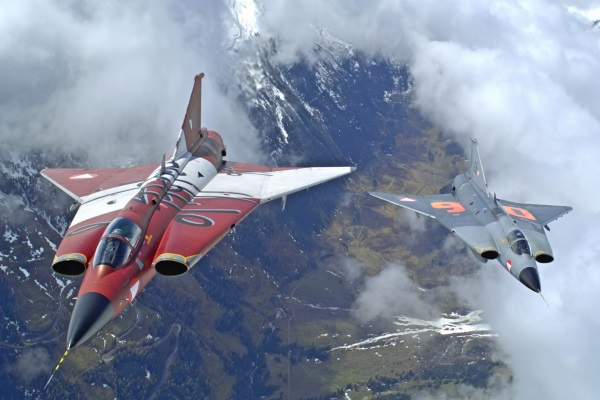
* In 1949, the Royal Swedish Air Board issued a request with the designation "Project 1200" for a new interceptor that would follow the SAAB 29 "Tunnan", then about to go into service with the Flygvapnet (Swedish Air Force). This new aircraft was to have a speed of at least Mach 1.4; be able to operate off specially-built sections of public roadway under the Swedish BASE 90 distributed airbase scheme; and was to be rugged, easily maintained, and cheap to operate.
A SAAB engineering team under Erik Bratt examined a number of options, but finally focused on a delta-wing design under the follow-on "Project 1250", with the aircraft a radical sweepback of 70 degrees. Further design studies led to a "double delta" scheme, featuring a thick inner delta with a sweep of 80 degrees providing accommodation for fuel and landing gear, and a thin outer delta with a sweep of 57 degrees providing additional lift for low-speed flight and short-field operation, while retaining low-drag characteristics for high-speed flight.
Nobody had ever flown a double delta aircraft before. After some wind tunnel experiments and flights of pulsejet-powered models on pivot line around a pole, the wing scheme was validated using a 70% scale demonstrator aircraft, the "SAAB 210", nicknamed the "LillDraken (Little Dragon)". The configuration was so radical at the time that some Flygvapnet personnel were shocked, one general protesting: "What the hell is this? An aircraft must have a damned tail, for heaven's sake!"
The SAAB 210 had a tailfin, but like any good full-delta aircraft, it had no tailplane. Although SAAB engineers did make sketches of the SAAB 210 with a full tail assembly and even performed some tests of wind-tunnel models with the full tail, the SAAB 210 remained tailless. The wind tunnel tests actually showed that the tailed configuration was unstable.
The first full flight of the LillDraken was on 21 January 1952, with SAAB test pilot Bengt Olow at the controls. The SAAB 210 was powered by an Armstrong Siddeley Adder turbojet with 3.92 kN (400 kgp / 880 lbf) thrust. That wasn't enough power, and in fact, in summertime the little aircraft was often flown in the cool dark hours of the morning. Despite this limitation, the LillDraken performed about a thousand test flights before being put out to pasture in the Flygvapnet museum.
In its original configuration, the engine intakes of the SAAB 210 were on the nose of the aircraft, separated by a small nosecone in the shape of a pyramid. The nose cone was later modified to a chisel shape, but the intake scheme did not provide enough airflow and so the entire forward fuselage was finally redesigned, modifying it with a long nose and moving the intakes back. The final configuration was given the designation of "SAAB 210B", earlier configurations retroactively becoming the "SAAB 210A".
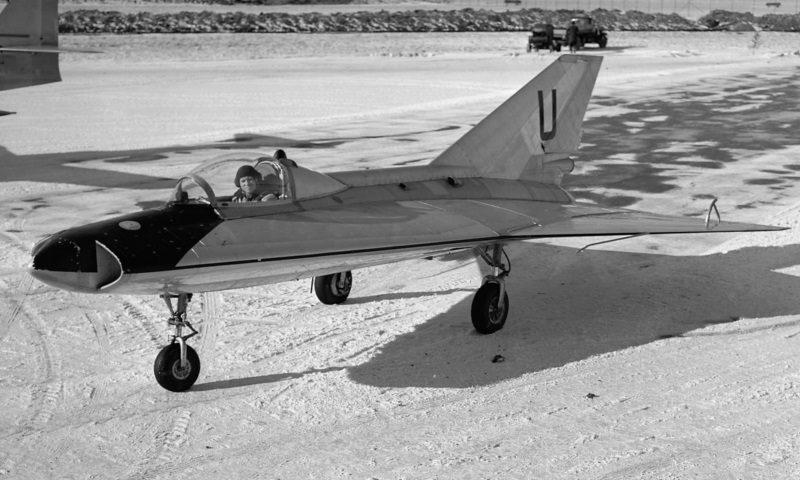
* In August 1953, the Swedish government ordered three prototype and three preproduction "SAAB 35 Draken" fighters, based on the LillDraken design. The British Avon 200 turbojet was selected as the powerplant for the production machine. A license was obtained by Svenska Flygmotor (later Volvo Flygmotor) to manufacture the Avon.
The first of the three SAAB 35 prototypes flew on 15 October 1955, again with Olow at the controls. It was originally powered by a non-afterburning Svenska Flygmotor RM5A engine, a copy of the Avon Mark 21 and the same engine used to power the SAAB 32 Lansen, but the prototype was later re-engined with a more powerful non-afterburning Avon Mark 43 engine, one of six provided by Rolls-Royce. With the improved engine, the initial prototype broke Mach 1 in level flight on 26 January 1956.
Unfortunately, the first prototype suffered damage during a belly landing on 19 April 1956, and ended up in the shop for several months. The second prototype, with a still more powerful Avon Mark 46 engine, had performed its first flight in March 1956, but it had bellied in a week before the accident that laid up the first prototype, and for the moment the program was dead in the water as far as flight tests were concerned.
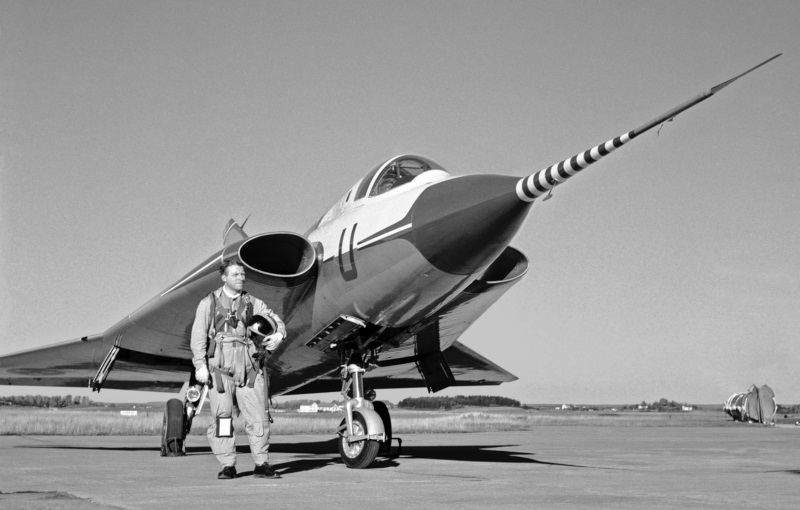
The third prototype was in the air in September 1956 and flight tests resumed, with the other two machines eventually repaired and rejoining the program. All three of the initial prototypes put in fair stints in test and evaluation, with the first machine ending up in a museum; the second destroyed in a ground fire in 1965; and the third ending up at a technical school for stress and fatigue testing.
The type was approved for full production in 1956 as the "J 35A (Adam)", where "J" stood for "Jakt (Fighter)". By that time the specifications had been raised, dictating a fighter with a top speed of Mach 1.8. Two more prototypes were built with J 35A features, both flying in 1958. The first, which was actually the fifth prototype in the number sequence, was originally fitted with an imported Avon Mark 48A engine, but later refitted with the equivalent Swedish-built RM6B engine, which was to be the production J 35A powerplant. The second, the fourth prototype in the number sequence, had the RM6B engine from the outset. Both these machines also were retained for test and evaluation, with the number-five prototype ultimately ending up in the Flygvapnet museum.
Following successful evaluation of the prototypes, the J 35A was put into series production. First deliveries to the Flygvapnet were in March 1960.
BACK_TO_TOP* The Draken proved to have excellent performance and was, for such a "hot" machine, relatively straightforward to fly. It did have some unpleasant quirks that needed to be worked out. For example, in initial service it proved to be touchy around the pitch (nose up / down) axis, resulting in nasty oscillations that led to some crashes. Some pilots claimed the oscillations could be set off by their heartbeat! Less sensitive flight control system modifications were retrofitted to early aircraft and got the problem under control.
The only fundamental limitations of the type, common to jet aircraft of that era, were that it had limited range and endurance, and as a delta it had a relatively long take-off run, since it was difficult to get flaps to work effectively with it. The Draken was easy to maintain, with the fuselage bolted together at midsection to make it straightforward to pull apart for engine access. The outer wing sections could be easily removed for shipping or storing the aircraft.
Flight control was provided by a rudder and elevons running the width of the rear of the wing. The elevons operated in unison for pitch control and in opposition for roll control. The elevons were split, with one on the inboard section of each wing and the other on the outboard section. The flight control surfaces were driven by a dual redundant hydraulic system. There was a small airbrake on either side of the fuselage, near the end of the wing. Initial production Adams featured the RM6B engine with a Swedish-designed EBK 65 afterburner, providing 47.1 kN (4,800 kgp / 10,600 lbf) dry thrust and 66.7 kN (6,800 kgp / 15,000 lbf) afterburning thrust.
The pilot sat in a simple SAAB-designed ejection seat, reclined 30 degrees to help deal with gee forces, under a clamshell-style canopy that hinged on the rear. The cockpit was pressurized and air-conditioned. The Draken had tricycle landing gear, with single wheels on each assembly. The nose gear had a mudguard for rough field operation and retracted backward, while the main gear hinged from the wing root to retract outward into the wing. The main gear legs contracted during retraction. A drag chute was fitted at the base of the tailfin to reduce landing roll. A pop-up ram-air turbine was provided for emergency power.
The J 35A was armed with twin 30-millimeter British Aden revolver-type cannon, with one cannon in each inner wing section, outboard of the engine intake. There were 90 rounds per gun. One confusing issue about the Draken is the number of stores pylons, particularly since it changed during the aircraft's evolution. It appears that the J 35A originally had a single centerline pylon and a pylon under each outer wing. Each wing pylon normally carried a single Rb24 air-to-air missile (AAM), which was a license-built US AIM-9B Sidewinder heat-seeker AAM; while the centerline pylon was "wet" and was usually used to carry an external tank with a capacity of 530 liters (140 US gallons). The tank featured twin tailfins. A dual launch rack could be fitted to the centerline pylon to permit the Adam to carry a total of four Rb24s.
Photos of Adams seem to show that they were generally left in natural metal finish in service. However, eventually the Flygvapnet would give most of their Drakens a camouflage paint scheme known as "fields & meadows", with a disruptive pattern of dark green and blue on top and light blue-gray on the belly.
The Adam was essentially a day interceptor, intended for tail chase pursuit. It featured PS-02/A radar, integrated into an Ericsson-built French Thomson-CSF Cyrano S6 fire-control system (FCS) along with a PN-793/A IFF (identification friend or foe) system. A Swedish copy of the US-built Lear L-14 autopilot was also fitted. A few J 35As were later modified with the SB6 FCS, which included an infrared search and track (IRST) sensor under the nose.
90 J 35As were built in all. The first three were pre-series aircraft, while the next seventeen were operational evaluation machines lacking radar and other essentials, and so it wasn't until the 21st J 35A that the type reached a stable standard. The last 28 were fitted with an improved EBK 66 afterburner, which incidentally resulted in a laughably long engine assembly, demanding a longer rear fuselage with revised contours. This in turn demanded fit of a pair of small retractable "roller skate" tailwheels to keep the rear of the aircraft from scraping the runway during high angle of attack take-offs or landings. Earlier J 35As had a small solid bumper for this purpose, which was said to have left a spectacular trail of sparks when it struck the tarmac.
Machines with the EBK 66 afterburner could be fitted with three stub pylons at the end of each wing, with each pylon carrying two Bofors 135-millimeter (5.3-inch) unguided rockets for a secondary ground attack role. Some sources claim the Adam could also carry iron bombs and the like, but if so that appears to have been an unusual configuration.
BACK_TO_TOP* The J 35A led to the next model, the "J 35B (Bertil)". Work on the Bertil had actually been initiated in 1956, even before the Adam went into production, the plan being to introduce a new Draken variant with more thrust and improved avionics as soon as possible. The J 35B prototype, a modified J 35A, performed its initial flight on 29 November 1959, and the type entered service with the Flygvapnet in 1961.
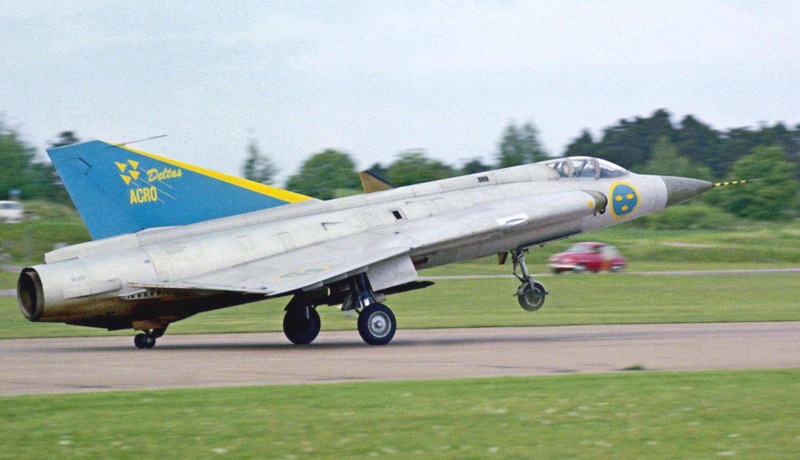
The J 35B was supposed to use the substantially improved RM6C engine, PS-03/A radar, and S7 FCS, but none of these things were ready when the airframe was. As a result, all J 35Bs were delivered with the RM6B engine and no combat avionics. Apparently they were simply used for training and evaluation until they could be brought up to operational spec, in the 1964:1965 timeframe.
The Bertil looked almost identical to the late-build Adam, with the longer rear fuselage and twin tailwheels, but featured the SAAB S7 FCS, which introduced support for the Swedish "STRIL 60 (Stridsledning och Luftbevakning / Combat Guidance & Air Surveillance)" network. While the J 35A had been limited to tail-chase intercepts, the SAAB 37 FCS and the STRIL 60 network allowed the J 35B to perform "collision course" intercepts, hitting the target from the front or the side -- a neat trick for two fast-moving aircraft.
Since the Rb24 Sidewinder had to be boresighted on a target's exhaust, it was useless for collision course intercepts, and so J 35Bs fitted for the interceptor role generally carried two 19-round Bofors 75-millimeter (3-inch) folding-fin unguided rocket pods on a dual stores rack fitted to the centerline pylon. These rocket pods had a "frangible" fairing on the nose that the rockets simply blasted through, with the fairing making the pod hard to distinguish from an external tank, except that it was smaller. The Bertil could also be used in a secondary ground-attack role, carrying 135-millimeter rockets.
A number of J 35As and J 35Bs were flown by the Flygvapnet "Acro Delta" flight demonstration team, which was formed in 1963 in place of the "Acro Hunter" team, which of course had used the Hawker Hunter. The Drakens of the Acro Delta team acquired smoke generators and a white paint job, featuring a blue tailfin with yellow trim. No doubt the fast Draken, with its sleek arrowhead shape, made an impressive demonstration aircraft. The Acro Delta team was disbanded in 1966, but Drakens were fielded for public flight demonstrations on a more informal but still regular basis until 1982, with special display teams put together on occasion well after that.
73 J 35Bs were built in all, with one retained by SAAB for test and evaluation purposes. J 35Bs received some updates in service, most significantly a new ejection seat with improved low-level, low-speed capability.
* The J 35 was a fairly hot aircraft, and so a tandem two-seat trainer version, the "Sk 35C (Caesar)" was developed, first flying on 30 December 1959. The "Sk" stood for "Skol", meaning of course "school" or "training". The instructor sat in the rear seat in a raised position behind the cadet pilot, and had a stereoscopic periscope to improve his forward visibility. The periscope apparently left something to be desired, the view being described as something like "staring through two toilet paper tubes", but was better than nothing.
There was a windblast screen between the student and instructor seats to protect the instructor in case of a bird strike or other accident broke the windscreen. The canopy opened to the side. The second seat was fitted by reducing the size of the fuselage fuel tanks, but in compensation the two Aden cannon were deleted, allowing larger fuel tanks in the wings. Air-intercept radar was deleted as well, but the Caesar retained stores pylons, and Sidewinders or other AAMs could be carried for training.
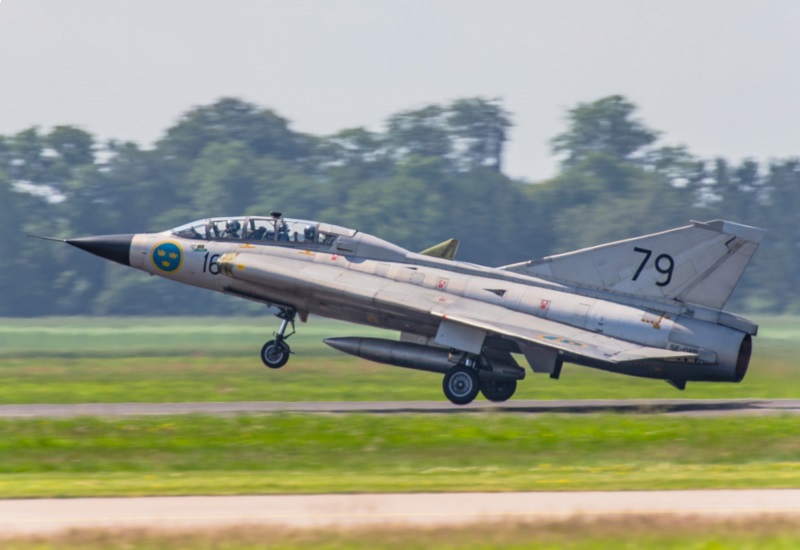
A total of 26 Caesars, including the prototype, were rebuilt from early production J 35As, with the Model 65 afterburner and short fuselage. Some sources claim the initial prototype was a new-build machine, but that seems to be an error. Unlike the single-seat Flygvapnet Drakens, the Caesars were not camouflaged, flying in natural metal finish through their careers. In 1966, all the Sk 35Cs were modified with improved radios, a navigation radar, and other small changes. A particularly visible element of this modification program was the addition of a small fin under each wing to improve yaw stability, which had been degraded by the new big canopy.
* As mentioned, SAAB had been hoping to obtain an uprated engine for the J 35B, designated the RM6C, which was a copy of the substantially uprated Rolls-Royce Avon 300 "big bore" engine, fitted with the Swedish EBK 66 afterburner. The RM6C could provide 56.4 kN (5,750 kgp / 12,700 lbf) dry thrust, and 76.8 kN (7,830 kgp / 17,260 lbf) afterburning thrust.
When the RM6C finally became available, it resulted in a new Draken variant, the "J 35D (David)", which was the first Mach 2 Draken. The only really noticeable external change from the J 35B was that the engine inlets were modified, being extended forward under the canopy. The new engine was unsurprisingly thirstier than the old, and so the David featured increased fuel capacity. The J 35D also replaced the centerline pylon with twin side-by-side fuselage pylons, both of which were "wet"; the wing pylons were also wet, meaning the David could carry four external tanks instead of one.
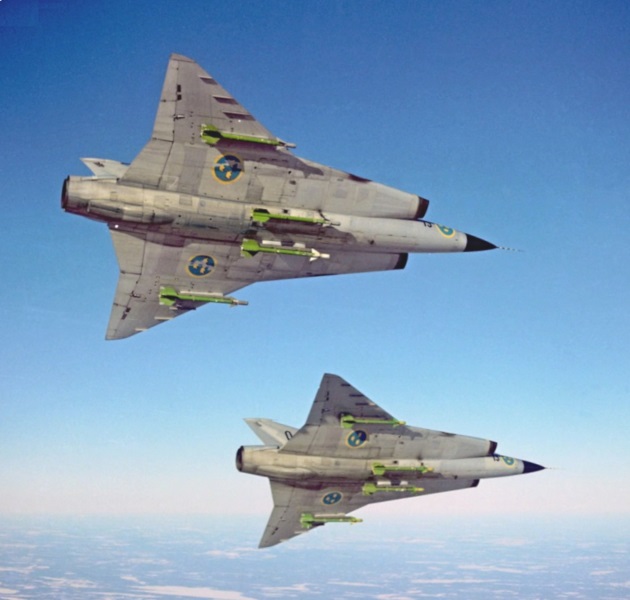
Other improvements included a SAAB FH5 autopilot replacing the license-built Lear unit; an improved SAAB S7A FCS with Ericsson PS-03 radar; and a new SAAB 73SE-F rocket-boosted ejection seat, which could operate from zero altitude but required a minimum forward speed of 100 KPH (62 MPH) for safe ejection. The J 35D was later updated with the SAAB RS35 ejection seat, which was a true "zero-zero" device that could get the pilot out safely even if the aircraft was sitting on the runway. All later Drakens would feature this zero-zero seat.
The prototype J 35D, a modified J 35A, performed its first flight on 27 December 1960, but deliveries to the Flygvapnet only began in 1963. 92 Davids were built. Some early production J 35Ds were delivered without radar, since the PS-03 was not ready for service at the time. These machines were mothballed until they could be fitted for full service.
* SAAB then developed an unarmed photo-reconnaissance version of the J 35D, designated the "S 35E (Erik)", where "S" stood for "Spaning (Reconnaissance)". It carried a total of seven French-designed OMERA narrow-view or wide-angle cameras:
The nose cone was mounted on rails so it could be easily slid out for access to the cameras. The pilot had a downward-staring periscopic sight to help target photographs, and also had a cockpit voice tape recorder to allow him to provide a commentary along with mission imagery. Of course, the S 35E had no radar, but aside from these changes and the lack of cannon, it was generally identical to a David. It could carry four external tanks, just like the David. A chaff-flare dispenser could be carried in place of one of the wing tanks. It is unclear if Eriks ever carried defensive armament such as Sidewinders.
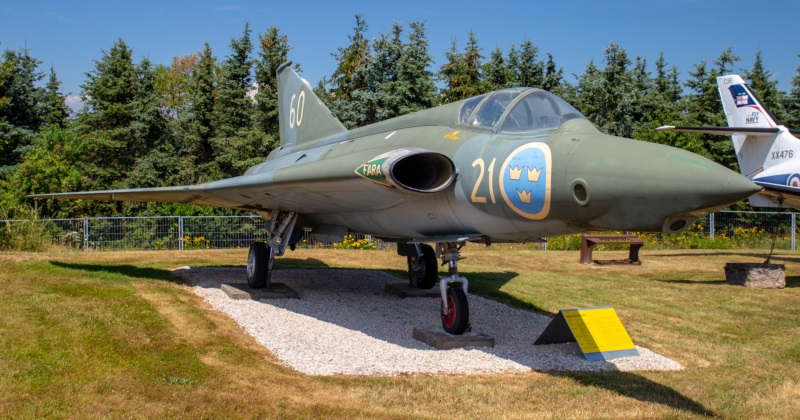
Early production Eriks had the RM6C engine with the EBK 66 afterburner, and the same canopy used on earlier Draken variants. Late production Eriks featured the RM6C engine with the improved EBK 67 afterburner, which provided 78.5 kN (8,000 kgp / 17,640 lbf) afterburning thrust, and were also fitted with a "bulged" canopy introduced on the J 35F, discussed below.
The S 35E prototype, a conversion of a J 35D, performed its first flight on 27 June 1963. The first production Erik performed its initial flight on 13 May 1965, with deliveries to the Flygvapnet beginning that summer. A total of 60 Eriks was built. 28 of these were originally ordered as Davids, but converted to Eriks on the production line.
In the 1970s, the Eriks were given an "apparat 15" upgrade that included a modernized film-camera suite; the ability to carry the Vinten Blue Baron night-photography pod on a centerline pylon; and fit of a modern, sophisticated countermeasures system -- with chaff-flare dispensers tacked onto the sides of the engine exhaust, plus two small jammer pods on special pylons on the outer wings.
* The J 35D also led to the definitive J 35 variant, the "J 35F (Filip)", with first flight of a prototype, a modified Adam, on 22 December 1961 and service introduction in 1965. Development was conducted with three modified J 35As, one of which was brought up to an approximation of full J 35F production specification.
The Filip was much like a late-production J 35D, with the RM6C engine and EBK 67 afterburner, as well as the bulged canopy. The major improvement was a SAAB S37B collision-course FCS with Ericsson PS-01/A radar, used in conjunction with a new armament scheme, with the J 35F carrying two semi-active-radar-homing (SARH) Rb27 AAMs and a single heat-seeking Rb28 AAM or an Rb24 Sidewinder AAM under each wing. The Rb27 and Rb28 were US Hughes Falcon AAMs built under license in Sweden. The SARH Rb27 was too heavy to be carried on the wing pylons, which is why only two could be carried. The S37B FCS worked in conjunction with the STRIL 60 ground-control network over a datalink to help target the Rb27 missiles.
The left Aden cannon was deleted to accommodate new avionics systems. The Falcon AAM saw little combat use and its effectiveness has been debated, though it must be acknowledged the effectiveness of all early AAMs was unimpressive. It is unclear how useful the J 35F's armament would have been if things had come to a shooting match; it appears the Draken never fired a shot in anger. However, the Swedish Falcons were by no means simple copies of the American models, and much was done to improve the weapon's effectiveness.
___________________________________________________________________
SAAB J 35F DRAKEN:
___________________________________________________________________
wingspan:
9.4 meters (30 feet 10 inches)
wing area:
49.2 sq_meters (529.6 sq_feet)
length:
15.4 meters (50 feet 4 inches)
height:
3.89 meters (12 feet 9 inches)
empty weight:
8,250 kilograms (18,190 pounds)
MTO weight:
12,270 kilograms (27,050 pounds)
maximum speed (clean):
2,125 KPH (1,320 MPH / 1,150 NMI)
service ceiling:
20,000 meters (65,600 feet)
range (with stores):
1,300 kilometers (800 MI / 695 NMI)
___________________________________________________________________
The Filip also featured an improved cockpit layout and updated navigation, autopilot, and communications systems. Later production J 35Fs were fitted with a Hughes AN/AAR-4 (S-71N) IRST, built under license by Ericsson. Machines with the IRST were designated "Filip Tvaa" or "J 35F2", read here as "J 35F-superscript-2", with the early machines retroactively designated "Filip Ett" or "J 35F1", read here as "J 35F-superscript-1".
A total of 230 Filips was built. They were the last new-build Drakens for Swedish service. In the late 1960s, SAAB proposed a new-build fighter-attack variant, the "JA 35", where "JA" stood for "Jakt Attack". It featured new radar and other kit, and wind-tunnel tests were performed on the modified configuration. However, the Flygvapnet was committed to the more capable multirole SAAB 37 Viggen, and the JA 35 was a non-starter.
BACK_TO_TOP* The Flygvapnet's Draken force provided excellent service through the 1960s and 1970s, but the type began to be removed in service in the mid-1970s with the retirement of the early Adams and Bertils. The phasing out of the Draken force accelerated in the late 1970s and early 1980s as the Viggen became the backbone of Flygvapnet air power.
The Swedes seem to really like getting their money's worth out of their aircraft, and there was some reluctance to simply discard old Drakens. They were still excellent aircraft, if not quite the latest thing any more. In the late 1970s, SAAB resurrected the AJ 35 strike-fighter concept in the form of a fairly drastic upgrade, known as the "35 MOD".
This upgrade envisioned fitting Filips with retractable canard fins mounted on the engine intakes; extended wingtips with a dogtooth; and a new strike-oriented avionics suite. The modifications would have allowed the fighter to carry a heavy strike load and still use the BASE 90 system of distributed short airstrips -- but 35 MOD was not approved.
A simpler Filip update program was, however, approved to maintain the J 35F's usefulness in the air defense role. The upgraded aircraft were originally referred to "J 35F Mod", but by the time the first of them were returned to service after their trip back to the factory, they were given the designation of "J 35J (Johan)". Logically speaking the next variant code should have been "J 35G", but these updated machines were to all go to F10 Wing, and since "J" is the tenth letter of the alphabet Flygvapnet brass decided that "J" would be the better suffix code.
67 upgrades from low-time J 35F-2s were performed in all, with the last re-delivered in August 1991. (One of the upgrades was actually a prototype that hadn't gone into service.) The J 35J received a comprehensive avionics upgrade, including improved radar, FCS, IRST, navigation gear, computer, and some modernized cockpit electronics. The only really visible change in the J 35J from the J 35F was the addition of a new stores pylon on the inner section of the wing, giving a total of six pylons.
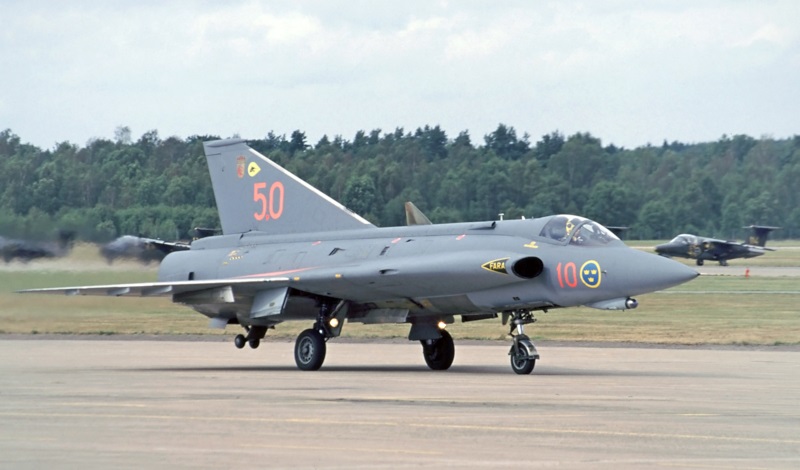
Incidentally, as long as single-seat Drakens were in service, Sk 35Cs had to be around to provide training support, and so the Caesar had an extended service life as well. It doesn't appear that the Sk 35C was ever given any major updates.
The last J 35J was phased out of formal service with the Flygvapnet on 8 December 1998, over 40 years after the initial flight of the first Draken prototype. Even in its old age, the Draken was regarded as a prize mount by Flygvapnet pilots, since its performance was still impressive -- and the fact that it wasn't as easy to fly as later aircraft, such as the Viggen, made it more of a challenge.
BACK_TO_TOP* While the Swedes, with a custom of military neutrality, are not traditionally aggressive arms exporters, the Draken was purchased by several European nations.
It took some time to make sales. In 1960, the Swiss evaluated a "J 35H" Draken -- "H" stood for "Helvetia", the old Latin name for Switzerland -- as a replacement for their antiquated de Havilland Vampires in the interceptor role. The J 35H was to be fitted with Ferranti AI.23 Airpass collision-course radar system, used in the English Electric Lightning. The evaluation of the J 35H went well, but the Swiss opted for the French Dassault Mirage III instead. A later proposal for an export attack variant, the "AS 35X", where "X" stood for "Export", with a dogtooth wing and a US-built GE J79 turbojet engine, also went nowhere.
However, Denmark did acquire a dedicated ground-attack Draken, along with reconnaissance and trainer machines. In 1968, the Danish government selected a J 35F derivative designated the "J 35X" for the Danish Air Force. The J 35X was similar to the J 35F, but had greater fuel capacity; a maximum external warload of 4,500 kilograms (10,000 pounds); structural reinforcement; a new outer wing; stronger landing gear to handle greater weights; and a runway arresting hook. Interestingly, the runway arresting hook had been part of the Draken design from the start, but SAAB hadn't fitted it to Flygvapnet aircraft.
The Danes ended up buying a total of 51 Drakens. Three different variants were obtained:
20 F 35s were delivered in the 1970:1971 timeframe. The F 35 was bought to replace the North American F-100D Super Sabre in the ground attack role. The F 35 lacked radar. It had two Aden cannon, the new stores pylon on the inner wing as fitted on the J 35J, and a second stores pylon on each outer wing, giving a total of eight stores pylons. It could carry unguided rocket pods and bombs, as well as Sidewinder AAMs for self-defense and large 1,275 liter (336 US gallon) external tanks. The Danes modified some of the large external tanks to carry pilot luggage.
The F 35 received a series of upgrades during its service career. In the early 1970s, a US AN/ALR-45 radar warning receiver (RWR) was installed, to be followed later in the decade by chaff-flare dispensers, fitted in the tailcone. The RWR was later updated to the AN/ALR-65.
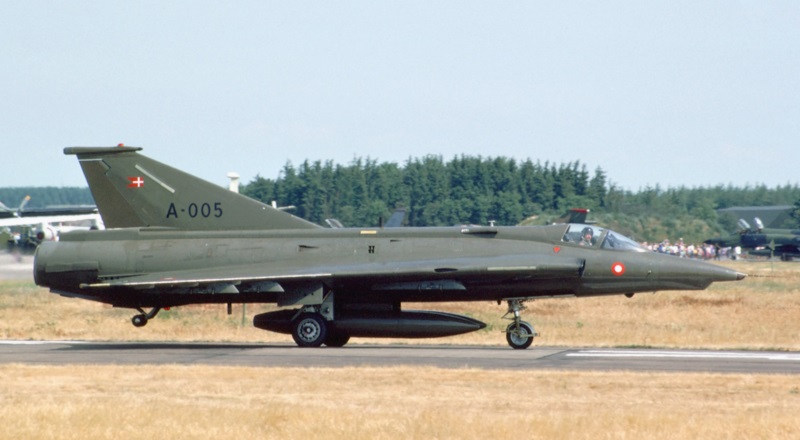
In the 1980s, the F 35s were put through a comprehensive "Weapons Delivery & Navigation System (WDNS)" upgrade program that involved fit of:
With these upgrades, the F 35 was a highly capable and modern strike aircraft.
20 RF 35 reconnaissance-fighters were delivered in 1971:1972 to replace Denmark's Republic RF-84F Thunderflashes. These reconnaissance Drakens featured a camera nose, a derivative of that fitted to the S 35E, and were also provided with Vinten Red Baron infrared reconnaissance pods in the mid-1970s. The RF 35s did not have wing cameras. They retained twin Aden cannon and had stores pylons, giving them a secondary attack capability. They were given the WDNS upgrade in the 1980s, though of course they did not get the Ferranti LRMTS. Apparently the new nose fitted to the upgraded F 35s to accommodate the LRMTS was a modification of the camera nose fitted to the RF 35, and after the upgrade it was very difficult to tell the two variants apart.
Eleven TF 35 trainers were purchased in two batches. Six were delivered in 1971:1972 as part of the order for the F 35s and RF 35s, with an additional batch of five delivered in 1976:1977. These machines were similar to Swedish Sk 35Cs, with a tandem canopy and a stereoscopic periscope for the back-seater, but were fitted with RM6C engines and EBK 67 afterburners, and were combat-capable, retaining a single Aden cannon. They could carry A-38K jammer pods for electronic countermeasures missions. The TF 35s were also given the complete WDNS upgrade, including the LRMTS in the modified nose.
In addition, the Danes acquired five S 35Es and two J 35Fs, all ex-Flygvapnet machines, as spares hulks. The Danish Drakens were expected to serve well into the 1990s, but they were out of formal service by 1993, since the end of the Cold War had led to defense cutbacks. Some of the Danish Drakens ended up in the hands of a test pilot's school in California, and at last notice were still in service.
* In 1970, Finland decided to obtain the Draken, arranging to buy twelve "J 35S" AKA "J 35XS" interceptors in kit form for local assembly by Valmet. "S" stood for "Suomi", meaning "Finland". These machines were similar to the J 35F, but had twin Aden cannon and a revised avionics suite. Initial flight was in 1974, with deliveries completed in 1975. The Finnish Drakens served in both the interceptor and fighter-bomber roles.
As an interim measure to provide training experience before the J 35XS fighters were available, the Finns leased six J 35Bs from Sweden, giving them the designation "J 35BS". These aircraft were apparently stripped of most of their combat avionics. The first was delivered in 1972. One was grounded after being badly damaged in 1974, and the Finns leased another J 35B to replace it.
In 1975, the Finns decided to buy these seven aircraft outright, since they had become enthusiastic about the type, and also bought six refurbished Swedish J 35Fs with the designation of "J 35FS". They bought a second batch of J 35FS Drakens in 1984, again all refurbished Flygvapnet aircraft. In addition to the refurbished fighters, in 1975 the Finns obtained three refurbished Sk 35C trainers with the designation of "Sk 35CS", and purchased two more refurbished Caesars in 1984, along with the second batch of J 35FS Drakens. This somewhat complicated history gave a total Finnish Draken force of 48 aircraft:
Finnish Drakens served into the 21st century, finally being withdrawn in favor of Finland's new F/A-18 Hornet fighters. The last Finnish Draken was removed from service in August 2000.
* The final user of the Draken was Austria. After considering a number of options for a replacement for the country's SAAB 29 Tunnans, which had gone out of service in 1972, the Austrians settled on used Flygvapnet J 35Ds, buying 24 of them in 1985. The aircraft were refurbished and modernized to an extent, for example being fitted with bulged J 35F-style canopies. They were delivered in the 1987:1989 timeframe.
The Austrian Drakens were given the designation of "J 35O", where the "O" stood for "Oesterreich (Austria)". Austria did not buy any Sk 35Cs, flight training being provided in Sweden as part of the sales package. A few Sk 35Cs were retained in operation in Sweden after retirement of the J 35J for this purpose.
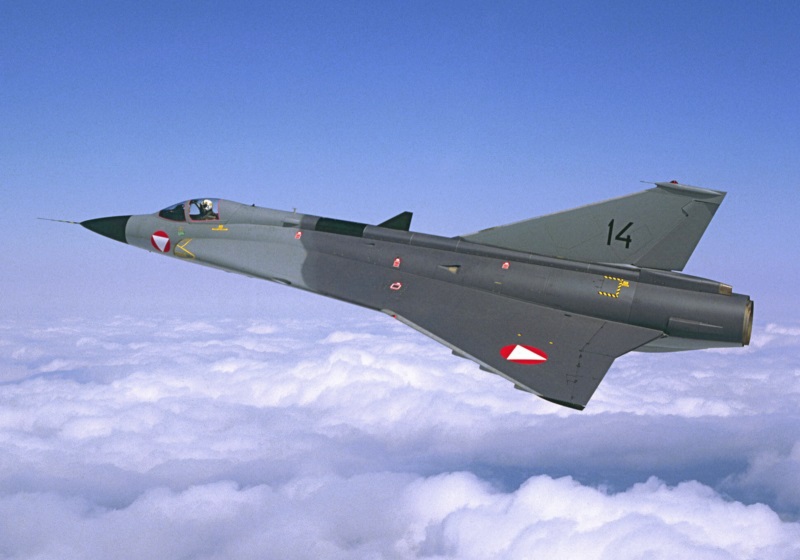
The J 35Os were used as primarily as interceptors, though the Austrians did obtain reconnaissance pods as well. Austrian Drakens were usually painted in a very tidy two-tone gray air-superiority camouflage scheme. Initially, the J 35Os were solely armed with their twin Aden cannon, since Austria's neutrality agreements prevented the fighters from carrying Sidewinders or other AAMs. After the fall of the USSR the rules were relaxed, and in 1993 the Austrians acquired surplus Swedish Sidewinders to arm their J 35Os. The Austrian Drakens were also then fitted with RWRs and chaff-flare dispensers, salvaged from retired Danish Drakens. The upgrade was performed by Valmet of Finland.
The J 35Os were supposed to be retired from service in 1998, but finding a replacement proved time-consuming. The last Drakens were withdrawn from service in November 2005, being replaced over the short term by Northrop F-5E Tiger II fighters leased from Switzerland, and later by early-model Eurofighters.
BACK_TO_TOP* A total of 614 Drakens was produced. The list below gives the various Draken variants:
It should be noted that the names "Adam", "Bertil", "Caesar", and so on are merely the Swedish military phonetic alphabet, equivalent to calling the J 35A an "Alpha", a J 35B a "Bravo", an Sk 35C a "Charlie", and so on.
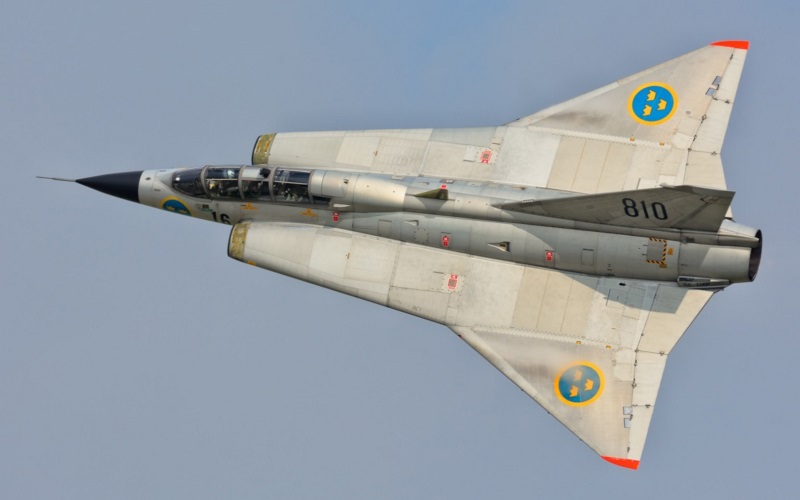
* Sources include:
Some items were also pulled off Urbain Fredericksson's Draken page.
* Illustration credits:
* Revision history:
v1.0 / not dated v1.1 / 19 jul 97 / Minor tweaks, added reader comments. v1.2 / 22 sep 97 / A few more tweaks. v1.3 / 08 jan 99 / Note on last Swedish Draken. v1.4 / 02 mar 99 / Moved revision history to end. v2.0.0 / 01 apr 02 / General update and enhancement. v2.1.0 / 01 apr 04 / Considerable cleanup and modification. v2.1.1 / 01 apr 06 / Review & polish. v2.1.2 / 01 aug 06 / Review & polish. v2.1.3 / 01 aug 08 / Review & polish. v2.1.4 / 01 jul 10 / Review & polish. v2.1.5 / 01 jun 12 / Review & polish. v2.1.6 / 01 may 14 / Review & polish. v2.1.7 / 01 apr 16 / Review & polish. v2.1.8 / 01 mar 18 / Review & polish. v2.1.9 / 01 jan 20 / Review & polish. v2.2.0 / 01 dec 21 / Illustrations update. v2.2.1 / 01 nov 23 / Review & polish. v2.2.2 / 01 nov 25 / Review & polish.BACK_TO_TOP
